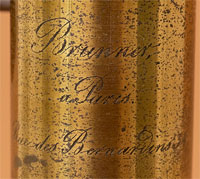 |
|||||
 |
 |
||||
 |
|||||
 |
 |
||||
Drum Microscope by Jean Brunner (No. 321) |
||||||||
 |
||||||||
| Age: c1835 Made by: Jean Brunner Made in: Paris |
||||||||
 |
||||||||
|
Brunner
a Paris rue des Bernardin 34 |
||||||||
| Johann Josef ("Jean") Brunner (1804-1862) was born in Balsthal in Canton Solothurn, Switzerland. He was the son of a locksmith, and apprenticed to his father. Early in his life he first moved to Basel where he worked for three years with a "balance maker", then at the age of 22 moved to Vienna and worked with Starke learning how to make scientific instruments. In 1828 he moved to Paris and became known as "Jean" Brunner. There Brunner first worked with Frédéric Hutzinger, then finally with the famous instrument maker Vincent Chevalier. In the early 1830s Brunner opened his own shop on 34 rue Bernardin*. At this location Brunner produced a variety of different types of scientific instruments including dividing engines, theodolites, magnetic compasses, and microscopes. In 1845, he moved his workshop to 183 rue de Vaugirard The address engraved on the tube of this microscope suggests that the microscope was made before the move. His sons Emile 1834-1895 and Leon 1840-1894, continued the business as Brunner Freres until 1895; the year Emile died**. What is interesting is that Nachet and Brunner have a common story. We know one microscope, entered in the CNAM collection in 1844, is signed by Brunner and Nachet. What means that the lens were made by Nachet, and the microscope body by Brunner. At this time, Camille Nachet was established at "quai aux Fleurs 17" and only as a maker of achromatic lenses . It's only in 1847 that Nachet established a workshop where he also manufactured the stands of his new microscopes. Thus, it is highly likely that the lenses on this Brunner microscope were made by Nachet***.
This Drum-Style microscope has a circular base with an inserted parabolic mirror mounted on a vertically sliding rack. The circular stage at the top of the drum base has X and Y movement controlled by thumbscrews. Mounted in the stage is a four-position aperture. Ascending from the back of the stage is the support pillar for the microscope body. This pillar also contains the fine focus mechanism. Cantilevered from the pillar is a brass sleeve into which the microscope body inserts. This sleeve houses the rack & pinion coarse focus. The microscope consists of a brass body tube plus drawtube. One end is threaded for the objective, the other allows the eyepiece to be dropped in. In the center of the body tube is inserted a field lens. Thus the optics consist of a Huygenian eyepiece, Field lens, and multi-lens objective. The objective is typical French with three, ganged plano-convex lenses. On the side of the brass sleeve is engraved "Brunner a Paris, rue Bernardin 34". The total height of the instrument is 33cm. There are no additional objectives or accessories with this specimen. *See this document for a complete description of Brunner's scientific career. **This site also has a description of the Brunner workshop. *** Information from A. Piffault Microscope featured 06/2019. |
||||||||